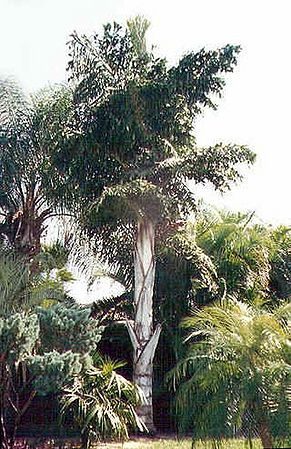Caryota rumphiana
| Caryota (kahr-ee-OH-tah) rumphiana (room-pee-AHN-ah) | |||||||
|---|---|---|---|---|---|---|---|
 Hidden Valley, near Mt. Kaindi, Morobe, Papua New Guinea. Photo by Dr. William J. Baker, Royal Botanic Gardens, Kew/Palmweb. | |||||||
| Scientific Classification | |||||||
| |||||||
| Synonyms | |||||||
|
| |||||||
| Native Continent | |||||||
|
| |||||||
| Morphology | |||||||
| |||||||
| Culture | |||||||
|
| |||||||
| Survivability index | |||||||
|
| |||||||
| Common names | |||||||
|
| |||||||
Contents
Habitat and Distribution
Caryota rumphiana is found in the Bismarck Archipelago, Maluku, New Guinea,Moluccas, New Guinea, and Austrailia on the north-eastern Cape York Peninsula, from Cape York south, to the MacIllwraith Range, usually east of the Great Divide, and at altitudes below 600 meters. Caryota is a Caryotoid genus of 12 species occuring from India and Sri Lanka through south-east Asia to the Solomon Islands and Queensland. The only indigenous Australian species is not endemic, but has a wide distribution through parts of Malesia and Melanesia - C. rumphiana, the Australian population of which is refered to C. rumphiana var. australasica. Restricted to subequatorial monsoonal north-eastern Cape York Peninsula from Cape York south to the MacIllwraith Range, usually east of the Great Divide and at altitudes below 600 m. Commonly in lowland rainforest of varying soil types, i.e. sandy, basaltic, granitic and alluvial, on a range of aspects from flat to steep slopes. Also in semi-deciduous vine forests, broad-leaved swamp forests and brackish or fresh mangroves, contrary to previously published accounts (3). The present sp. occurs as infrequent to frequent scattered individuals or small to large groups, apparently never forming stands. It is particularly abundant in the Bamaga and Iron Range areas where it is a common but not dominant member of the rainforest communities. Pollenation is by insect, seed dispersal by flood, birds or mammals. In rainforest this species attains its maximum development, being smaller in all respects in vine forests (dry) or swamp-forests (wet).
Description
Trunk type: Solitary, Light Grey/Dark Tan, Widely Spaced Rings. Trunk diameter: To 45 cm (18"). Hight: To 18 meters (60 feet). Spread: To 6 meters (20 feet). Leaf detail: Pinnately compound, bipinnate, to 3 meters (10 feet) long, dark green, petiole up to 90 cm (36") long. Flower detail: Golden, drooping, mop like in appearance. Fruit detail: Round, 20 mm (0.75") across, Red/Pink To Dark Red/Black, seeds dark brown, approximately 1.75 centimeters (.5 inches) across. Editing by edric.
Culture
Requirements: Filtered light when young, full sun when mature, consistently moist soil, well drained position.

Comments and Curiosities
This is a monocarpic species.
- IMAGE GALLERY
External Links
- Glossary of Palm Terms
- MODERN BOTANICAL LATIN
- "Just To Be Clear"
- http://www.flickr.com/photos/tags/Caryota%20albertii
- http://wildflowerquest.blogspot.com/
References
Phonetic spelling of Latin names by edric.
Special thanks to Geoff Stein, (Palmbob) for his hundreds of photos.
Special thanks to Palmweb.org, Dr. John Dransfield, Dr. Bill Baker & team, for their volumes of information and photos.
Glossary of Palm Terms; Based on the glossary in Dransfield, J., N.W. Uhl, C.B. Asmussen-Lange, W.J. Baker, M.M. Harley & C.E. Lewis. 2008. Genera Palmarum - Evolution and Classification of the Palms. Royal Botanic Gardens, Kew. All images copyright of the artists and photographers (see images for credits).
Many Special Thanks to Ed Vaile for his long hours of tireless editing and numerous contributions.
























